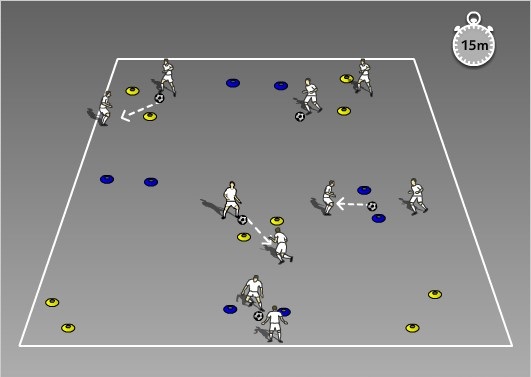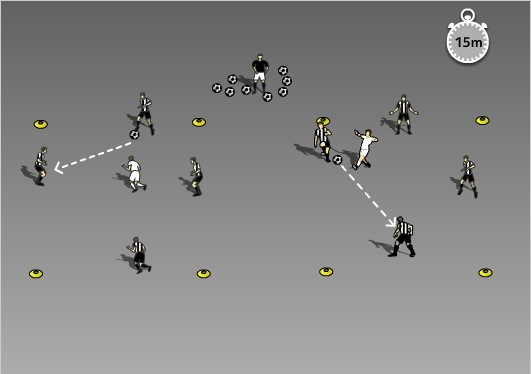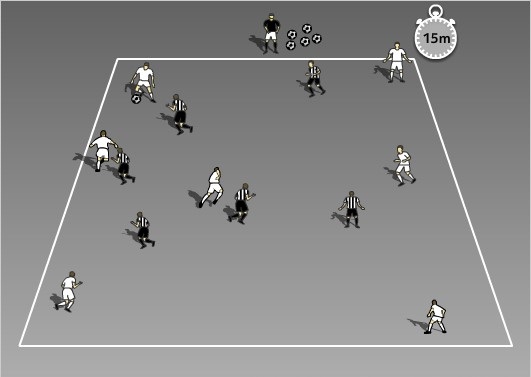An excerpt from:
Session #3: Pass and Move to Create Space
This session is designed to introduce your players to the fundamental attacking concept of passing and moving to create space. Again, this session is appropriate for any level of player and can also be used at the beginning of the season to make sure all players know the basics of passing the ball and how they fit into a team that tries to keep possession of the ball.
What will players learn from this session?
- [The first activity] demands players to work together as they look for open gates to pass through (support).
- This session encourages players to develop spatial awareness and move accordingly in order to help their team to maintain possession of the ball (support, mobility, width, depth).
- This session also develops close ball control, use of both feet, and encourages sharp changes of pace and direction in a relatively crowded area (mobility and improvisation).
- Successful players will keep their head up and eyes open to see where the space is, but also to recognize the visual cues of the defender (e.g., where is she looking, are they favoring one particular side, are they weak on one side, what is their body position?).
- Players must solve the problem of escaping pressure in a confined space (improvisation).
- This session encourages players to switch the point of the attack to a less well-defended area and to play in tight spaces where necessary (width and improvisation).
Coaching Points for the session:
- Praise players when they “take a look” to see where the space is.
- Praise creativity (even when it doesn’t come off).
- Praise players for trying to keep possession of the ball and not panicking (booting the ball).
- Praise players who make intelligent angles for the ball (try to stay away from square angles).
- Praise players who make good angles but don’t receive the ball (they are most likely creating space for someone else).
- Praise players who make good pass selection decisions (not necessarily execution).
Guided discovery questions for the session: (can be asked at any point)
- What surfaces of the foot are the most useful here? Why do you think this is?
- [In the first activity] What do partners need to do to be successful at this game? Show me.
- [In the first activity] How do you know where the open gates are? Show me.
- [In the first activity] What is the best distance between partners so that you can be most efficient? Show me.
- What can you do to support your teammate when she has the ball? Show me.
- What types of things can you communicate to make it easier for your teammate(s)?
- Should we be making the field as big as possible or group together? Why?
- Should you be aiming to play fast or slow? Why?
- Where should you aim to take your first touch to avoid the defenders taking the ball? How?
- Is it easier to keep the ball when it is on the ground or in the air? Why?
- Do you always want to play short passes in this game? Why?
- What are the visual cues to send a long ball, as opposed to a short pass? Explain that to me.
- Why is the weak side so important in this game? Explain that to me.
Warm-up Activity: The Gate Passing Game

Time: Approximately 15 minutes.
Area: 25×25 yards (L x W) or larger, depending on how many players you have.
Activity: Put players in pairs with a ball. Set up a number of 1.5-yard-wide gates randomly arranged in your grid. The size and number of gates can vary depending on the number of pairs of players you have and their skill level. I would start with at least as many gates as pairs. Players score a point for each completed pass they make through a gate to their partner. Go for 30-45 seconds and have pairs keep count of how many points they get. See how many they get and ask how the top pair got so many. Get them to demonstrate. Repeat. Switch partners. Repeat.If your players are struggling with this game, make the gates bigger. The objective is simply to get them passing with their partner on the move. You should always start an activity so that everyone can quickly find success. Once they understand the game, that’s what you can start to make it progressively more challenging.
Possible Progressions:
Add a restriction that players must use a certain foot or surface of the foot to make a pass and score a point.
Replace some of the gates with pinnies (or different colored gates) and say that pairs must go through a cone gate followed by a pinnie/bib gate.
Make the gates smaller/reduce the number of gates.
Introduce
a bandit (or pair of “bandits”) whose job is to stop pairs from scoring in
gates. Change the bandit(s).
Activity #1: 4v1

Time: Approximately 15 minutes.
Area: Set up grids of approximately 10 x 10 yards (make bigger if you have weaker players).
Activity: While staying in the grid at all times, 4 players attempt to keep the ball away from 1. Play rounds of 30-45 seconds. When the time is up change the person in the middle. Have each group keep count of the highest number of consecutive passes they managed. The first pass is always “free” (e.g., the defenders must allow it). The group with the lowest number of passes does a quick consequence (e.g., 20 toe taps, 5 knees to chest, 5 sit-ups, etc.).
4v1 is a great warm-up activity for your team. It gets them a lot of touches on the ball, requires them to deal with pressure, and forces them to make decisions. Depending on numbers, you can make it 4v2, or 3v1.
Possible Progressions:
Put touch restrictions on the players (e.g., 3 touch max, then 2 touch max, then 1 touch).
Mandate that players must follow their pass (constant movement/chaos).
Put the attacking team on the outside of the grid with one of them in the middle.
Mandate
that all passes must cross two lines to count (this means that the players
keeping the ball must stand outside the grid).
Activity #2: Basic Possession

Time: Approximately 15 minutes
Area: 50 x 60 yards (W x L), or as close to half a game field as you can get. Start big, you can always make it smaller.
Activity:Split players up into two teams of even numbers, with the objective being to keep the ball for as long as possible (a coach can keep count by counting the seconds out loud – I would suggest the first 5 are in your head!). Give them a certain amount of time (e.g., 3 minutes) and then take the highest number of consecutive seconds in possession from each team to declare a winner. If you have a large number of players (e.g., more than 20), you may want to consider using 2 smaller grids (in order to maximize the players’ number of touches and learning situations). If you have a smaller number of players (e.g., 12 or less), you may want to make the field smaller.
Possible Progressions:
Make it so teams score a goal by keeping the ball for 10 seconds. Play first team to score 3 goals, wins.
Add a neutral(s), so the team in possession always has a slight advantage.
Put all players on a touch restriction (e.g., 3 touch maximum, 2 touch maximum).
Add a halfway line and mandate that teams may only starting counting passes that are completed in the opponents’ half.
*

